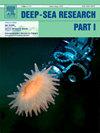A video dataset for hadal snailfish along with the benchmark
IF 2.1
3区 地球科学
Q2 OCEANOGRAPHY
Deep-Sea Research Part I-Oceanographic Research Papers
Pub Date : 2025-05-27
DOI:10.1016/j.dsr.2025.104517
引用次数: 0
Abstract
Application of deep learning technology for deep-sea ecological studies is still in its infancy stage especially in the field of automatic taxonomic identification and statistics. In this study, we created a novel dataset containing annotated videos for the rare species of hadal snailfish inhabiting in depth below 6000 meters, and conducted control experiments by combining models of different specifications and adding different attention mechanisms. We successfully generated a set of benchmark test data from a quantitative perspective. In addition, based on out of set data with completely different data distributions from the training and validation sets, the generalization ability of the model trained on the new dataset in real-world scenarios was qualitatively analyzed. Other researchers can continue to expand and supplement the dataset based on our benchmarks, or directly apply our results to actual deep-sea videos collected, and accurately identify and capture deep-sea snailfish in the videos. With this deep learning video processing technology, distribution pattern and biodiversity of the deep-sea organisms will be accomplished efficiently.
hadal蜗牛鱼的视频数据集以及基准
深度学习技术在深海生态研究中的应用还处于起步阶段,特别是在自动分类识别和统计领域。本研究对生活在6000米以下的稀有物种hadal蜗牛鱼创建了一个全新的包含注释视频的数据集,并通过组合不同规格的模型和添加不同的注意机制进行了对照实验。我们成功地从定量的角度生成了一组基准测试数据。此外,基于与训练集和验证集数据分布完全不同的集外数据,定性分析了在新数据集上训练的模型在真实场景下的泛化能力。其他研究人员可以在我们的基准基础上继续扩展和补充数据集,或者直接将我们的结果应用到实际收集的深海视频中,准确识别和捕获视频中的深海蜗牛鱼。利用这种深度学习视频处理技术,可以有效地完成深海生物的分布格局和生物多样性。
本文章由计算机程序翻译,如有差异,请以英文原文为准。
求助全文
约1分钟内获得全文
求助全文
来源期刊
CiteScore
4.60
自引率
4.20%
发文量
144
审稿时长
18.3 weeks
期刊介绍:
Deep-Sea Research Part I: Oceanographic Research Papers is devoted to the publication of the results of original scientific research, including theoretical work of evident oceanographic applicability; and the solution of instrumental or methodological problems with evidence of successful use. The journal is distinguished by its interdisciplinary nature and its breadth, covering the geological, physical, chemical and biological aspects of the ocean and its boundaries with the sea floor and the atmosphere. In addition to regular "Research Papers" and "Instruments and Methods" papers, briefer communications may be published as "Notes". Supplemental matter, such as extensive data tables or graphs and multimedia content, may be published as electronic appendices.

 求助内容:
求助内容: 应助结果提醒方式:
应助结果提醒方式:


